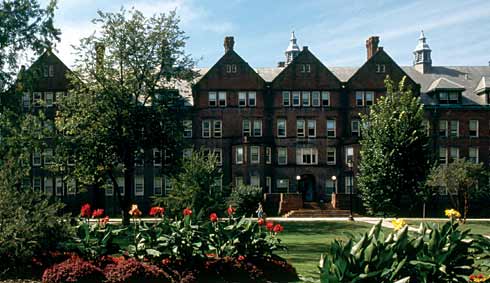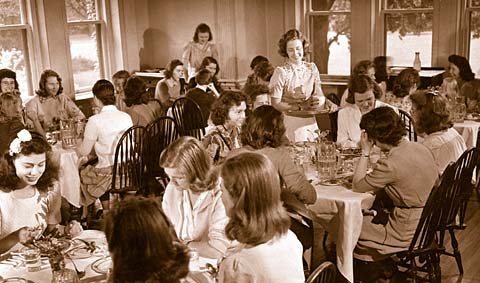Strong House
Vassar’s quad dormitories—Davison, Raymond, Lathrop, and Strong—appear so externally similar that Vassar students themselves sometimes have a difficult time remembering exactly which is which. Most alumnae/i can remember at least one disorienting moment standing in the shadows of these imposing, red-brick buildings, when reciting “Dear Robert Louis Stevenson,” the mnemonic device created to help keep the names and locations in order, might have come in handy. For those attending Vassar after 1969, however, one of these dorms, Strong House, isn’t nearly as easy to mix-up. Designated as an all-female dorm at the beginning of coeducation, Strong maintains this distinction today. And on a campus where housing with coeducational corridors and bathrooms is much more typical—and popular—Strong’s women nonetheless often have particular memories of why they chose, or stayed in, the dorm.

Take Cecilia (Chechi) Mendez Hodes ’72, for example. After attending coeducational schools all of her life, Mendez Hodes wanted specifically to attend a women’s college, recognized at the time for their academic excellence, she remembered, and applied early decision to Vassar. “I think that I became aware that Vassar would become coeducational only after it was too late to apply elsewhere, and in any case, I thought that having applied early decision and been accepted, I could not renege,” she said. Happily, though, she enrolled, “not expect[ing] that [her] life would be affected very much by the addition of men to the school in the first years of the change.”
Mendez Hodes spent her freshman year living in Raymond House. But men began to arrive at Vassar in the spring of 1969, and some of the first were assigned to Raymond. She found that “living in a coed dorm was a bit of a rambunctious experience in the early days in a way that, I believe, would not now be the case. There were some exuberant characters and some turmoil, not involving me personally, but it was just part of the package, as having men there was so new.” Because she’d had a bit of experience living in the all-female Raymond, Mendez Hodes eventually moved to Strong, where she liked the “peacefulness and coziness of an all-female house” and had the opportunity to focus more intensely on her academic and extracurricular pursuits.
Despite the abrupt transition to coeducation that would forever change residential life at the college, maintaining an all-female dorm helped connect the old Vassar to the new. Mendez Hodes remembered: “I have a general memory of a certain sweetness to living in Strong, and everyone sitting on the floor in the living room after dinner (all meals took place in individual houses), playing bridge, and having demitasse (we were assigned turns cleaning the coffee urns) for a while before going off to study or an evening activity. It felt like our home.”

Strong dining room before coeducation
Residents of Strong in the late ’60s and early ’70s were likely raised in an era when interactions between the sexes were more structured. When Mendez Hodes first entered Vassar there was a dress code: “You had to wear a skirt to go into town, and if you were meeting with a professor.” Therefore, the informality of living exclusively with other women was a draw. Appearance and demeanor seemed less important when men, often in the parlors on Strong’s first floor, couldn’t appear unannounced on the upper floors. The desk messengers—called White Angels during Mendez Hodes’ time at Vassar—“had a code when they rang the corridor phones to tell us someone was waiting for us downstairs,” she recalled. “The White Angel (or your fellow student if she was doing work duty or relaying the message upstairs) would say, ‘You have a visitor,’ if the person was female, but, ‘You have a guest,’ if the visitor was male.” This practice applied to all men—even males enrolled at the college—Mendez Hodes said, so that “you’d know not to run downstairs with rollers in your hair and wearing a bathrobe.... I liked the relaxed feeling of being able to flop around in our pajamas and underwear...in our dorm rooms and bathrooms.”
In addition to the home comforts of Strong, Mendez Hodes cherishes the bonds she developed with other women, and the direction these relationships provided for her future endeavors. “Some wonderful women lived in Strong....[S]omething I did not appreciate while living in Strong, that I understand better now, is how college is a time—perhaps the last such period for many people—where one’s principal job in life is to explore ideas and experiences in a way that may not be possible thereafter. How many opportunities will there be for most women, after Strong House, to experience living in an all-female context?” She continued: “Living in Strong gave me a chance to gather my wits and be encouraged by other women to listen to my own voice. It fortified me to weather mistakes, to try to do the right thing, and to set priorities that make sense for me, in later life. I learned the importance of doing things for others in community.”

Evaluating the benefits of Strong as an all-female residence, Mendez Hodes concluded, “Having been immersed in a predominantly male environment thereafter makes me particularly grateful to have lived those enriching years in Strong and at Vassar College. I would not exchange them for anything that I can imagine.”
Built in part by money donated by Trustee John D. Rockefeller and named in honor of his daughter Bessie Rockefeller Strong, special student from 1886–88, Strong House opened in 1893 as the first residence hall for students outside of Main Building. Obviously single-sex at its opening, Strong maintained this designation even after the transition to coeducation in the early ’70s.
Professor of English and former Dean of the College Colton Johnson remembered that it was decided to retain one single-sex residence “not as a symbolic gesture on the college’s part”—not as a constant reminder of the college’s history—“but more likely for two pragmatic reasons: a fair amount of the women already in the college had enrolled because Vassar was a women’s college, and they wanted their housing arrangements to stay that way. Also, there was no great pressure from the numbers of men in the early days [of coeducation], and thus no reason not to reserve a quad dorm for women.”
The decision to keep Strong single-sex hasn’t gone without debate, though. Johnson says that he recollects times in the ’80s and ’90s when suggestions that Strong might turn coeducational became more prevalent, owing to full enrollments and lack of interest in single-sex housing from enough women. As recently as 2002—when Jewett House was closed for extensive renovations, and many women were placed in Strong despite not wanting to live there—the argument for a coeducational Strong resurfaced. Lindsay Dawson ’05 said, “Many of the older girls supported Strong’s tight-knit female community, while the freshmen were largely in favor of abolishing it. Since few incoming students volunteer to live here, they argued, a single-sex dorm had become an antiquated, obsolete experiment.”

Strong residents celebrating their Serenading victory in 2004
Dawson did encourage residents to be patient and give Strong a try, since many, herself included, come to love the dorm—if only for its cleaner and quieter atmosphere. (Dawson’s father had required that she live there for her freshman year when he heard of Vassar’s coeducational bathrooms, and she remained thereafter.) But the anti-Strong sentiment amongst many of the newer women harmed the chance for fostering much of a sense of community in the dorm. Notwithstanding her positive experience living in Strong, Mendez Hodes commented: “The future of Strong is for the students of today and tomorrow to choose.... I think that if all students are offered an opportunity to live in the house arrangements they prefer, whatever that choice might be, then the community is probably happier, because all individuals have a chance to express themselves.”
Building community in the dorms is a priority for Vassar, and especially for the Dean of the College J. J. Jackson. Jackson, in cooperation with Dean of the Faculty Ron Sharp, has a plan for community building in the dorms that began this summer with renovations to common areas—sprucing up parlors and multipurpose rooms, and adding up-to-date audiovisual technology. This, she hopes, will provide an “appropriate and pleasing atmosphere” for the reintroduction of more activities—whether discussions, lectures, or movies—to individual dorms to help correct the “dissonance between where students live and learn.”

For Strong in particular, Jackson said, “We are not destroying community” by preserving an all-female dorm, but rather “allowing community to happen. Strong speaks to one lifestyle our students like, and represents one preference within the larger Vassar community.”
Indeed, Vassar takes pride in honoring student preferences by allowing students to choose this single-sex housing option within an otherwise fully coeducational environment. So whether for purely practical reasons, like Barbara Safranek ’82, who remained in Strong after being placed there freshman year “mainly as a strategy to get the largest single possible”; whether by parental mandate, like Dawson; or whether to be in a supportive and peaceful environment living only with women, like Mendez Hodes, Strong House provides some Vassar students the residential options they need.
Photo credits: Special Collections, Vassar College Libraries, 1972 Vassarion
Strong: Will Faller; Photo courtesy of Miscellany News
To share your memories of living in Strong House, please visit www.aavc.vassar.edu/discboard/.
